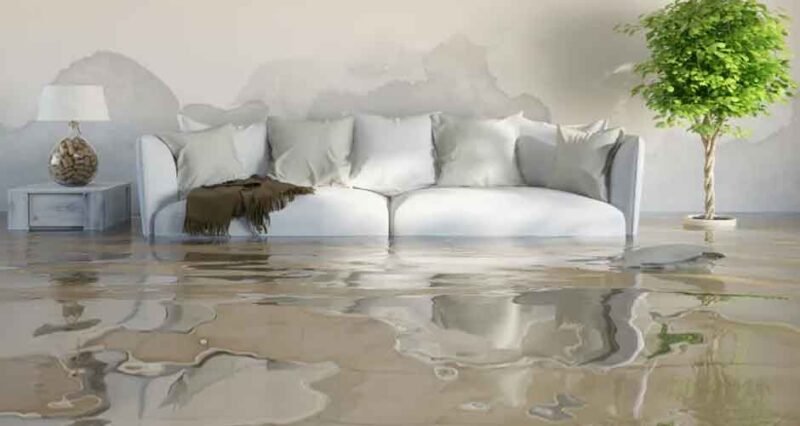
Water, a seemingly innocuous element, has the potential to wreak havoc on your home faster than you might imagine. Whether it’s a burst pipe, a leaking roof, or a flooded basement, water damage can escalate rapidly, causing extensive harm to your property warns KRS, a property management expert. Understanding the speed at which water damage can occur and knowing what immediate steps to take can make a significant difference in mitigating the destruction and minimizing the financial and emotional toll it can take on homeowners.
The Swift Onset of Water Damage
Water damage is a silent invader that can start causing harm within minutes. When a pipe bursts or a roof begins to leak, water initiates infiltrating your home’s structure immediately. In the initial minutes, it may seem like a minor inconvenience, but the reality is that water spreads swiftly, seeping into porous materials and causing damage that escalates rapidly. Within the first few hours of water intrusion, you can expect to see visible signs of damage. Paint and wallpaper may start to peel, wooden surfaces might warp, and fabrics can become saturated. The speed at which these changes occur can be alarming, leaving homeowners scrambling to assess and take action.
The Domino Effect: Hours Count
As hours pass, the consequences of water damage become increasingly severe. One of the most significant concerns during this time frame is the risk of mold growth. Mold spores are omnipresent in the air, and when they come into contact with moisture, they can begin to colonize and spread rapidly. Mold can cause health problems for occupants and lead to extensive structural damage. In addition to mold, the water can weaken the structural integrity of your home. Drywall may become soft and crumble, wooden supports may start to rot, and electrical systems can be compromised. The longer water is allowed to linger, the more extensive and expensive the repairs become.
The 24-48 Hour Danger Zone
The situation can become dire within 24 to 48 hours of water intrusion. If left unchecked, water damage can compromise the safety of your home and your family. For instance, electrical systems can short-circuit, boosting the risk of fires. Furthermore, the accumulation of moisture can weaken the foundation, ushering in structural issues that are both costly and hazardous. During this critical period, it’s not just the physical damage that becomes a concern. Water damage can also result in contaminated water entering your living space. This contaminated water poses health risks, as it can contain harmful microorganisms and pathogens. Immediate action is essential to mitigate these dangers.
Taking Immediate Action
The swift progression of water damage underscores the importance of taking immediate action when it strikes your home. Here are the steps you should take to minimize the damage and protect your property:
● Turn Off the Water Source:
The first crucial step in addressing water damage is promptly turning off the water source. If the water damage results from a burst pipe or a malfunctioning appliance, locate the main shut-off valve and close it tightly. This action effectively halts the influx of water into your home, preventing further damage. It’s paramount to know the location of this valve in advance to act swiftly in emergencies.
● Ensure Safety:
Safety considerations should take precedence during a water damage incident. Prioritize the safety of yourself and your family. If it’s safe, turn off your home’s electricity and gas supply to minimize the risk of electrical hazards or potential fires. Safety is paramount, and taking these precautions can stem accidents and injuries.
● Remove Excess Water:
Once you’ve addressed immediate safety concerns, concentrate on terminating excess water from the affected areas. Standing water is a primary contributor to the escalation of damage, so it’s paramount to eliminate it as soon as possible. Employ various water extraction strategies, including buckets, towels, mops, or a wet/dry vacuum. The faster you can rid your home of excess moisture, the less it will seep into surfaces and cause further harm.
● Move Belongings:
Safeguard your possessions by relocating them to dry, unaffected areas of your home. Furniture, electronics, and valuables should be elevated and moved away from the water-damaged areas. Placing these items on blocks or utilizing furniture coasters can help prevent further harm. By taking this proactive step, you reduce the risk of your belongings suffering irreparable damage.
● Ventilation:
Promote effective ventilation within your home to expedite the drying process. Open windows and doors to encourage airflow, allowing moist air to escape and fresh, dry air to enter. Utilize fans strategically to circulate air throughout the water-affected areas, expediting the drying process. Additionally, dehumidifiers can help extract moisture from the air, further aiding in restoration.
Water damage can infiltrate your home at an alarming speed, causing problems that can escalate from minor inconveniences to major disasters. The key to minimizing the impact of water damage is swift action. Recognizing the indications of water damage and knowing what immediate steps to take can make all the difference in protecting your home and investment. By acting promptly, you can mitigate the destruction, reduce repair costs, and ensure the safety and well-being of your family. Remember that water damage is not just about property damage; it’s about preserving your peace of mind and the comfort of your home. You can contact us if you need reliable water damage services in Seattle, WA.

